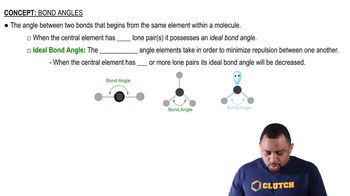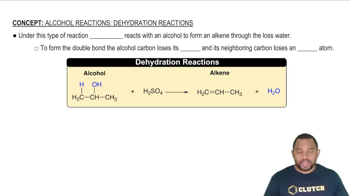The capacity of batteries such as the typical AA alkaline battery is expressed in units of milliamp-hours (mAh). An AA alkaline battery yields a nominal capacity of 2850 mAh. (b) The starting voltage of a fresh alkaline battery is 1.55 V. The voltage decreases during discharge and is 0.80 V when the battery has delivered its rated capacity. If we assume that the voltage declines linearly as current is withdrawn, estimate the total maximum electrical work the battery could perform during discharge.
Ch.20 - Electrochemistry
Chapter 20, Problem 106b
Disulfides are compounds that have S ¬ S bonds, like peroxides have O ¬ O bonds. Thiols are organic compounds that have the general formula R ¬ SH, where R is a generic hydrocarbon. The SH- ion is the sulfur counterpart of hydroxide, OH-. Two thiols can react to make a disulfide, R ¬ S ¬ S ¬ R. (b) What is the oxidation state of sulfur in a disulfide?
 Verified step by step guidance
Verified step by step guidance1
insert step 1> Identify the general formula for a disulfide, which is R-S-S-R, where R represents a hydrocarbon group.
insert step 2> Recognize that in a disulfide, the sulfur atoms are bonded to each other and to carbon atoms from the hydrocarbon groups.
insert step 3> Recall that the oxidation state of sulfur in thiols (R-SH) is typically -2, as sulfur is more electronegative than hydrogen.
insert step 4> Consider that when two thiols form a disulfide, the S-S bond is formed, and the oxidation state of sulfur changes.
insert step 5> Determine the oxidation state of sulfur in the disulfide by considering that the S-S bond is a covalent bond between two sulfur atoms, and each sulfur atom shares one electron with the other, leading to an oxidation state of -1 for each sulfur in the disulfide.

Verified video answer for a similar problem:
This video solution was recommended by our tutors as helpful for the problem above.
Video duration:
1mWas this helpful?
Key Concepts
Here are the essential concepts you must grasp in order to answer the question correctly.
Oxidation State
The oxidation state, or oxidation number, is a measure of the degree of oxidation of an atom in a compound. It indicates the number of electrons an atom has gained, lost, or shared when forming a chemical bond. In disulfides, understanding the oxidation state of sulfur is crucial for determining its chemical behavior and reactivity.
Recommended video:
Guided course

Oxidation Numbers
Disulfide Bond
A disulfide bond is a covalent bond formed between two sulfur atoms, typically represented as S-S. This bond is significant in biochemistry, particularly in stabilizing the structure of proteins. In the context of the question, recognizing the nature of the disulfide bond helps in analyzing the oxidation states of the sulfur atoms involved.
Recommended video:
Guided course

Bond Angles
Thiols and Their Reactions
Thiols are organic compounds containing a sulfhydryl group (-SH) and are characterized by their strong odor and reactivity. When two thiols react, they can form a disulfide bond through oxidation, resulting in the release of hydrogen. Understanding this reaction is essential for determining the oxidation state of sulfur in disulfides, as it illustrates the transformation of thiols into disulfides.
Recommended video:
Guided course

Alcohol Reactions: Dehydration Reactions
Related Practice
Textbook Question
4
views
Textbook Question
Disulfides are compounds that have S ¬ S bonds, like peroxides have O ¬ O bonds. Thiols are organic compounds that have the general formula R ¬ SH, where R is a generic hydrocarbon. The SH- ion is the sulfur counterpart of hydroxide, OH-. Two thiols can react to make a disulfide, R ¬ S ¬ S ¬ R. (c) If you react two thiols to make a disulfide, are you oxidizing or reducing the thiols?
